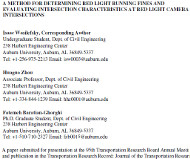Article from: www.thenewspaper.com/news/49/4938.asp
4/15/2016
Study: Most Red Light Camera Tickets Should Be $0
Researchers find that a red light camera fine set according to the risk of an accident would in most cases be $0.
 Researchers from Auburn University earlier this year told the Transportation Research Board annual meeting that the vast majority of red light camera tickets are issued for behavior that carries no risk. The team used real-world data from red light camera intersections in Opelika, Alabama to model the likelihood of a crash for certain types of driving behavior. For more than nine out of ten photo ticket recipients, the group suggested the risk-based fine should be $0.
Researchers from Auburn University earlier this year told the Transportation Research Board annual meeting that the vast majority of red light camera tickets are issued for behavior that carries no risk. The team used real-world data from red light camera intersections in Opelika, Alabama to model the likelihood of a crash for certain types of driving behavior. For more than nine out of ten photo ticket recipients, the group suggested the risk-based fine should be $0.
"Currently red light running fines are not based off of the risk imposed by the violator; instead, they are seemingly arbitrarily legislated," the report explained. "Prior to red light cameras, there was not an accurate way to judge this risk. However, the camera captures the exact instant the violator enters the intersection after red, thus allowing for a fine structure to be based off of that information."
The study calculated the probability of a conflict between opposing traffic when a vehicle runs the red light. A simulation model was then used to determine the risk of whether a crash happens or not based on how long the light had been red when the vehicle enters the intersection. The probability of a crash between 0.1 and 3.5 seconds after the light turned red was found to be zero percent, largely because of the all-red clearance interval prevents conflict. The risk jumps significantly after the light has been red for 4.4 seconds or longer.
The researchers used $85,438 as an estimate of the cost of a serious red light running crash. They then proposed a red light camera ticket issued when the light has been red for less than 3.5 seconds should be $0, but it should be $200 if the light had been red for 3.8 seconds. The cost would top out at $82,985 for a ticket issued 7.0 seconds after the red.
Although those hypothetical fines are large, they would be rarely issued. The Texas Transportation Institute found that more than half of all red light violations happen during the first half-second after the light turns red. Eighty percent of the violations happen in the first second.
 Researchers from Auburn University earlier this year told the Transportation Research Board annual meeting that the vast majority of red light camera tickets are issued for behavior that carries no risk. The team used real-world data from red light camera intersections in Opelika, Alabama to model the likelihood of a crash for certain types of driving behavior. For more than nine out of ten photo ticket recipients, the group suggested the risk-based fine should be $0.
Researchers from Auburn University earlier this year told the Transportation Research Board annual meeting that the vast majority of red light camera tickets are issued for behavior that carries no risk. The team used real-world data from red light camera intersections in Opelika, Alabama to model the likelihood of a crash for certain types of driving behavior. For more than nine out of ten photo ticket recipients, the group suggested the risk-based fine should be $0.